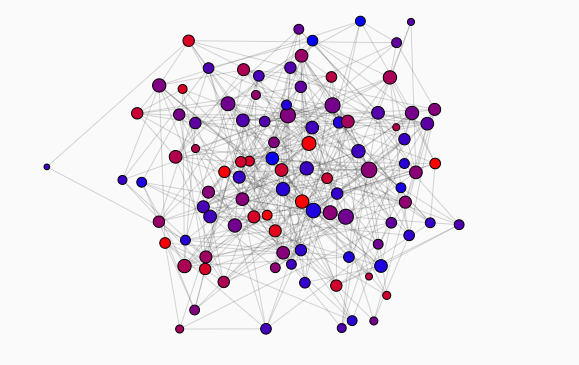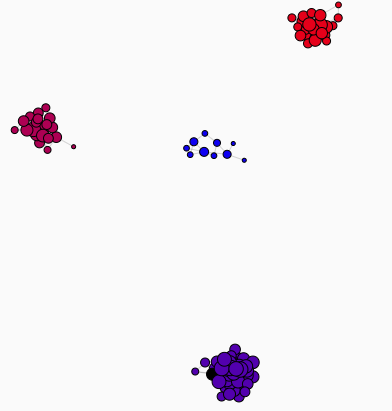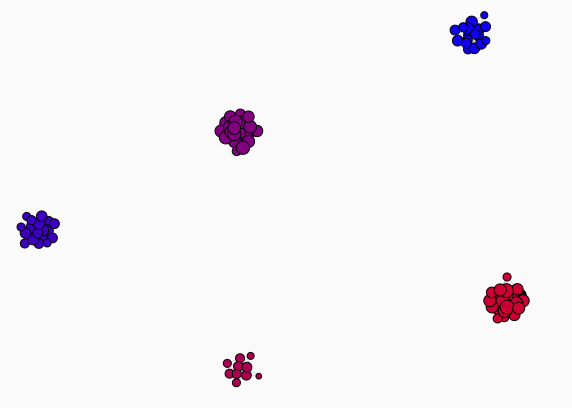Our Media Environment 2 — Breaking the Bubble
- Algorithms in social media platforms
- can be defined as technical means of sorting posts based on relevancy instead of publish time, in order to prioritize which content an user sees first according to the likelihood that they will actually engage with such content. Institute for Internet and the Just Society
- Media bubble
- is an environment in which one’s exposure to news, entertainment, social media, etc., represents only one ideological or cultural perspective and excludes or misrepresents other points of view. Dictionary.com
This lesson plan tackles the dreaded social media algorithms and how they result in echo-chambers: hearing only voices similar to our own, without exposure to the rest of society, especially people who disagree with us.
Lesson goals
- information literacy
- digital competency
- social media literacy
- critical thinking
Activities
Theory (10 minutes) - Teacher-centered
Present the theory on thebasics of how an algorithm works in social media and how this is different to real life.
Aim: the students understand the basic theoretic foundation of algorithm use by social media platforms and the difference to to how we access information outside of those platforms.
Example (10 minuten) - Teacher-centered
The teacher explains the exercise, shows the student both sites and sets up the groups.
Aim: the exercise can proceed.
Exercise (40 minutes) - Class divided into groups
The students play around with both tools and create short reports of their findings.
Aim: the students experience bubble-formation with both platforms, learning both about the mechanism of echo-chambers and about the effect this has on the worldview of an individual.
Discussion (30 minutes) - Class
The students present their reports, after which they discuss their findings.
Aim: the students reflect on their activity, discussing the problem of echo-chambers.
Discussion questions (optional) - Class
Discuss the discussion questions with the students
Aim: students reflect on the topic.
Keywords
Pedagogical tips and recommendations
- This is a digital tool heavy lesson, so be open to discovering and learning with the students.
- We highly recommend students should have computer access for this exercise.
Theory (10 minutes)
Most social media have what is called a feed. This is a virtual space in which content, such as textual content, images or videos, is displayed to a social media user. The content can be individual to each user, or tailored to different demographic groups. But who gets to decide what content is displayed and how?
Real life
- What we interact with is physically distributed in space.
- There is no single entity that controls the information.
- The distribution of information in space is decentralised. We choose some of the opinions we hear, for instance by buying a specific magazine, but we also do not have control over a lot of what we interact with, for instance, conversations we overhear in a bar.
Social media
- What we interact with is all collected on a uniform feed.
- There is a single entity (the social media platform in question) which controls the flow of information.
- The distribution of information follows a certain algorithm - in other words, a sorting method which dictates which content is provided to whom and when.
Social media platforms have a vested interest in retaining their users and increasing their engagement with the platform. This means they will want to display content that the users seem interested in and/or interact with the most. This leads to the corporations controlling social media having an incentive to create algorithms that in turn create echo-chambers: users enjoy viewing content they like and agree with.
In other words, social media platforms can use alhorhitms to target specific audiences by tailoring their feeds to match their preexisting preferences. A platform can push content from conservative news outlets, for example, to older people, who tend to be more conservative than the younger population.
Why so social media platforms do this? The short answer is profit. We live in an attention economy - an economical model in which companies compete for our attention as a scarce and valuable resource (every person has a limited amount of it). The more attention we give a social media platform, the more time we spend on it, which means we are exposed to more ads. The more ads we see and the better they are taylored to what data on us say a person in our demographic category might want to buy, the more likely we are to click on the ad or even buy the product it is advertising.
For example, if you are selling clothes, you could pay a social media platform to push ads for “going out dresses” to young women under 30, or buisness suits to men aged 30 to 65. After all, ad revenue is how social media platforms make the bulk of their profits. If you’re running a news outlet, you want those social media users to either pay for access to your content (i.e., you introduce a paywall) or go you your site to look at ads there!
Example (10 minuten)
The teacher explains the exercise, shows the student both sites and sets up the groups.
Exercise (40 minutes)
Let’s take a look at how this plays out in shaping our personal media environment. For this exercise, we will use two helpful digital tools:
- Split Screen, a social media bubble visualization tool demonstrating the difference in Facebook Newsfeed content shown to different demographics, and
- Osome, a social bubble simulation tool showing different sub-groups form on social media according to different parameters.
These two (or other similar) tools help visualize and understand how bubbles and echo-chambers work. You should let the students work in small groups.
The Split Screen
The Split Screen is a resource by The Markup, which shows the different news shown to different demographics. It is organised in several “match-ups”:
- Biden v. Trump voter
- Women v. Men
- Millennial v. Boomer
In all of these comparisons, you can choose a random date up to the 30th of June, 2022, and see what different news are shown to different demographics.
Task: Divide the class into groups (up to 5 students per group). Their task is to pick a certain date and check all the three comparisons. They should discuss their findings and prepare a short report. Give them 15 minutes to use the tool. Then, have a randomly chosen group select a group member to present their findings for 60 seconds. Randomly select the second group to present any findings that are in opposition or different to what the first group presented. Repeat until each group had the chance to present.
You can access Split Screen here.
Osome
Osome is a simulation platform where individuals in some social “web” are portrayed as points a graph, with connections between them signifying “friendship”, and their colors political spectrum from conservative (red) to progressive (blue). The simulation has three parameters:
- Tolerance: how tolerant an individual is to opposing views;
- Influence: how likely it is that an individual would change their point of view;
- Unfriending: how likely it is that an individual would unfriend a person and replace them with a new friend.
The simulation is simple: individuals post and when reading each other’s posts they either read the post and change their mind a little bit, or they get angry and unfriend that person, replacing them with another person.
You begin with a web like this one:

An unrealistic example with a high tolerance for opposing views, high influence on others and total lack of unfriending will lead to a very uniform society in which everyone’s a “friend” and in some sort of an interaction - a social web.
If we drastically change the parameters, we can get a different image:

Another drastic example, with low tolerance for opposing views, high influence on others and a lot of unfriending, will, on the other hand, create a very polarised society broken off into distinct sub-groups living in a state of total separation.
With low influence, there oppositions are even more radicalized:

Introduce the students to Osome and give them 15 minutes to play around and createa report of their findings. Again, have a randomly chosen group select a group member to present their findings for 60 seconds. Randomly select the second group to present any findings that are in opposition or different to what the first group presented. Repeat until each group had the chance to present.
You can access Osome here.